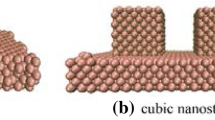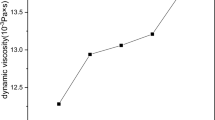Abstract
Frost on the evaporator surface of an air source heat pump can seriously reduce the heat pump coefficient of the unit, and the surface nanostructure is the key to effectively inhibiting water vapour condensation in the early stages of frosting. In this paper, the wetting process of nanodroplets on square column type, prismatic cone type and prismatic platform nanostructures was studied by molecular dynamics, and the nucleation and growth process of water vapour on three nanostructures were analysed. It was found that the droplets in the prismatic cone structure were less likely to reach a stable wetting state than in the other two structures. For the condensation process of water vapour on the surface of the three nanostructures, water molecules are more distributed on the surface of the prismatic cone matrix with a smaller size, and less distributed on the surface of the square column matrix with a larger size. The order of the clusters starting to merge is square column matrix, prismatic platform matrix and prismatic cone matrix. The results showed that the stable coagulation rates are, in descending order, a square columnar matrix, a prismatic platform matrix and a prismatic cone matrix. With the increase in the height of the prismatic cone matrix surface structure, the condensation rate of water vapour accelerates, the droplet size increases, and the condensation nucleus decreases. These findings can provide microscopic and fundamental suggestions for surface structure design to inhibit the early frosting of water vapour in the air.












Similar content being viewed by others
Data availability
The data presented in this study that support the findings are available on reasonable request from the corresponding author.
References
Yao Y, Jiang Y, Deng S, Ma Z (2004) A study on the performance of the airside heat exchanger under frosting in an air source heat pump water heater/chiller unit. J Int J Heat Mass Transf 47:3745–3756. https://doi.org/10.1016/j.ijheatmasstransfer.2004.03.013
Wu X, Dai W, Shan X, Wang W, Tang L (2007) Visual and theoretical analyses of the early stage of frost formation on cold surfaces. J Enhanced Heat Transfer. https://doi.org/10.1615/jenhheattransf.v14.i3.70
Li L, Wang W, Sun Y, Feng Y, Lu W, Zhu J, Ge Y (2014) Investigation of defrosting water retention on the surface of evaporator impacting the performance of air source heat pump during periodic frosting–defrosting cycles. J Appl Energy 135:98–107. https://doi.org/10.1016/j.apenergy.2014.07.028
Wang F, Wang Z, Zheng Y, Lin Z, Hao P, Huan C, Wang T (2015) Performance investigation of a novel frost-free air-source heat pump water heater combined with energy storage and dehumidification. J Appl Energy 139:212–219. https://doi.org/10.1016/j.apenergy.2014.11.018
Hayashi Y, Aoki A, Adachi S, Hori K (1977) Study of frost properties correlating with frost formation types. J Heat Transfer 99:239. https://doi.org/10.1115/1.3450675
Ma J, Cha H, Kim MK, Cahill DG, Miljkovic N (2019) Condensation induced delamination of nanoscale hydrophobic films. J Adv Funct Mater 29:1905222-1–1905222-10. https://doi.org/10.1002/adfm.201905222
Del Col D, Parin R, Bisetto A, Bortolin S, Martucci A (2017) Film condensation of steam flowing on a hydrophobic surface. J Int J Heat Mass Transf 107:307–318. https://doi.org/10.1016/j.ijheatmasstransfer.2016.10.092
Nouri N, Davar H, Navidbakhsh M (2021) Effects of superhydrophobic, hydrophobic and hybrid surfaces in condensation heat transfer. J Appl Fluid Mech 14:1077–1090. https://doi.org/10.47176/jafm.14.04.31843
Neinhuis C, Barthlott W (1997) Characterization and distribution of water-repellent, self-cleaning plant surfaces. J Ann Bot 79:667–677. https://doi.org/10.1006/anbo.1997.0400
Foshat S, Jafarpur K, Yaghoubi M (2021) Condensation heat transfer of a hybrid hydrophilic–hydrophobic surface with different arrangements. J Chem Eng Commun. https://doi.org/10.1080/00986445.2021.1958322
Sharma DK, Kumar R, Avasthi DK, Sikarwar BS (2020) Self assembly of super-hydrophobic nanotextured methyl functionalized silica on copper and aluminium surfaces for moist air condensation. J Colloids Surf A 605:125379. https://doi.org/10.1016/j.colsurfa.2020.125379
Peng B, Ma X, Lan Z, Xu W, Wen R (2015) Experimental investigation on steam condensation heat transfer enhancement with vertically patterned hydrophobic–hydrophilic hybrid surfaces. J Int J Heat Mass Transfer 83:27–38. https://doi.org/10.1016/j.ijheatmasstransfer.2014.11.069
Yang X, Law K-Y, Brillson L (1997) Low energy cathodoluminescence spectroscopy of sio 2 nanoparticles. J. Vac. Sci. Technol A 15:880–884. https://doi.org/10.1116/1.580725
Wang Q, Xu S, Xing X, Wang N (2021) Progress in fabrication and applications of micro/nanostructured superhydrophobic surfaces. J Surf Innov 10:89–110. https://doi.org/10.1680/jsuin.21.00031
Goswami A, Pillai SC, McGranaghan G (2021) Surface modifications to enhance dropwise condensation. J Surf Interfaces 25:101143. https://doi.org/10.1016/j.surfin.2021.101143
Wang F, Liang C, Yang W, Zhang X (2020) Effects of frost thickness on dynamic defrosting on vertical hydrophobic and superhydrophobic fin surfaces. J Energy Build 223:110134
Liu T, Sun W, Sun X, Ai H (2012) Mechanism study of condensed drops jumping on super-hydrophobic surfaces. J Colloids Surf A 414:366–374. https://doi.org/10.1016/j.colsurfa.2012.08.063
Khatir Z, Kubiak K, Jimack P, Mathia T (2016) Dropwise condensation heat transfer process optimisation on superhydrophobic surfaces using a multi-disciplinary approach. J Appl Therm Eng 106:1337–1344. https://doi.org/10.1016/j.applthermaleng.2016.06.128
Jin X, Zhang X, Peng Y et al (2015) Multifunctional engineering aluminum surfaces for self-propelled anti-condensation. J Adv Eng Mater 17:961–968. https://doi.org/10.1002/adem.201500046
Yao Z, Hao P, Zhang X, He F (2012) Static and dynamic characterization of droplets on hydrophobic surfaces. J Chin Sci Bull 57:1095–1101. https://doi.org/10.1007/s11434-012-5003-8
Mulroe MD, Srijanto BR, Ahmadi SF, Collier CP, Boreyko JB (2017) Tuning superhydrophobic nanostructures to enhance jumping-droplet condensation. J ACS Nano 11:8499–8510. https://doi.org/10.1021/acsnano.7b04481
Wen L, Xiao-Jing M, Jin-Liang X, Yan W, Jun-Peng L (2021) Effects of base angle and wettability of nanostructures on droplet wetting behaviors. J Acta Phys Sin 70:126101. https://doi.org/10.7498/aps.70.20201584
Fujii A, Fujiwara K, Ueki Y, Shibahara M (2020) Molecular dynamics simulation on effects of nanostructure on interfacial thermal resistance during condensation. J. Therm. Sci. Technol. 15:JTST0010–JTST0010. https://doi.org/10.1299/jtst.2020jtst0010
Hiratsuka M, Emoto M, Konno A, Ito S (2019) Molecular dynamics simulation of the influence of nanoscale structure on water wetting and condensation. J Micromachines 10:587. https://doi.org/10.3390/mi10090587
Liao M-J, Duan L-Q (2020) Dependencies of surface condensation on the wettability and nanostructure size differences. J Nanomater 10:1831. https://doi.org/10.3390/nano10091831
Gao S, Liu W, Liu Z (2019) Tuning nanostructured surfaces with hybrid wettability areas to enhance condensation. J Nanoscale 11:459–466. https://doi.org/10.1039/C8NR05772A
Rafiee J, Mi X, Gullapalli H et al (2012) Wetting transparency of graphene. J Nat Mater 11:217–222. https://doi.org/10.1038/nmat3228
Xu W, Lan Z, Peng B, Wen R, Ma X (2015) Effect of surface free energies on the heterogeneous nucleation of water droplet: A molecular dynamics simulation approach. J J Chem Phys 142:054701-1–054701-12. https://doi.org/10.1063/1.4906877
Hubao A, Yang Z, Hu R, Chen Y-F, Yang L (2020) Effect of solid–liquid interactions on substrate wettability and dynamic spreading of nanodroplets: a molecular dynamics study. J Phys Chem C 124:23260–23269. https://doi.org/10.1021/acs.jpcc.0c07919
Wei X, Zhong L, Ben-Li P, Rong-Fu W, Xue-Hu M (2015) Molecular dynamics simulation on the wetting characteristic of micro-droplet on surfaces with different free energies. J Acta Phys Sin 64:216801. https://doi.org/10.7498/aps.64.216801
Zhang J, Borg MK, Sefiane K, Reese JM (2015) Wetting and evaporation of salt-water nanodroplets: a molecular dynamics investigation. J Phys Rev E 92:052403. https://doi.org/10.1103/PhysRevE.92.052403
Li H, Yan T, Fichthorn KA, Yu S (2018) Dynamic contact angles and mechanisms of motion of water droplets moving on nanopillared superhydrophobic surfaces: a molecular dynamics simulation study. J Langmuir 34:9917–9926. https://doi.org/10.1021/acs.langmuir.8b01324
Highgate D, Knight C, Probert S (1989) Anomalous “freezing” of water in hydrophilic polymeric structures. J Appl Energy 34:243–259. https://doi.org/10.1016/0306-2619(89)90032-9
Jhee S, Lee K-S, Kim W-S (2002) Effect of surface treatments on the frosting/defrosting behavior of a fin-tube heat exchanger. J Int J Refrig 25:1047–1053. https://doi.org/10.1016/s0140-7007(02)00008-7
Lee H, Shin J, Ha S, Choi B, Lee J (2004) Frost formation on a plate with different surface hydrophilicity. J Int J Heat Mass Transfer 47:4881–4893. https://doi.org/10.1016/j.ijheatmasstransfer.2004.05.021
Shin J, Tikhonov AV, Kim C (2003) Experimental study on frost structure on surfaces with different hydrophilicity: density and thermal conductivity. J Heat Transfer 125:84–94. https://doi.org/10.1115/1.1518496
Wang F, Liang C, Yang M, Fan C, Zhang X (2015) Effects of surface characteristic on frosting and defrosting behaviors of fin-tube heat exchangers. J Appl Therm Eng 75:1126–1132. https://doi.org/10.1016/j.applthermaleng.2014.10.090
Zuo Z, Liao R, Zhao X et al (2017) Anti-frosting performance of superhydrophobic surface with zno nanorods. J Appl Therm Eng 110:39–48. https://doi.org/10.1016/j.applthermaleng.2016.08.145
Wang F, Liang C, Zhang X (2016) Visualization study of the effect of surface contact angle on frost melting process under different frosting conditions. J Int J Refrig 64:143–151. https://doi.org/10.1016/j.ijrefrig.2016.01.008
Yang S, Zhang Y, Chen L (2019) Molecular dynamics study on the effect of surface wettability on the performance of water vapor condensation. J AIP Adv 9:025031. https://doi.org/10.1063/1.5085228
Gao S, Liao Q, Liu W, Liu Z (2018) Coalescence-induced jumping of nanodroplets on textured surfaces. J J Phys Chem Lett 9:13–18. https://doi.org/10.1021/acs.jpclett.7b02939
Acknowledgments
The authors would like to thank the School of Civil Engineering and Construction for providing the liquid droplet contact angle measurement apparatus, Prof. Xiaoyan Liu for providing ideas and methods, Mr. Yang Yang and Mr. Shaotong Feng for their timely assistance in conducting the simulations, guidance on the simulation and theoretical analysis of this paper by Mr. Hubao A of Wuhan University and the support of the National Natural Science Foundation of China.
Funding
National Natural Science Foundation of China, grant number 52076036.
Author information
Authors and Affiliations
Corresponding author
Ethics declarations
Conflict of interest
This study does not present a conflict of interest with other individuals or institutions.
Additional information
Handling Editor: Annela M. Seddon.
Publisher's Note
Springer Nature remains neutral with regard to jurisdictional claims in published maps and institutional affiliations.
Rights and permissions
Springer Nature or its licensor (e.g. a society or other partner) holds exclusive rights to this article under a publishing agreement with the author(s) or other rightsholder(s); author self-archiving of the accepted manuscript version of this article is solely governed by the terms of such publishing agreement and applicable law.
About this article
Cite this article
Liu, X., Zhang, H., Jiang, H. et al. A study on the mechanism of water vapour condensation inhibition by nanostructures on the copper surface. J Mater Sci 57, 20615–20630 (2022). https://doi.org/10.1007/s10853-022-07828-y
Received:
Accepted:
Published:
Issue Date:
DOI: https://doi.org/10.1007/s10853-022-07828-y




